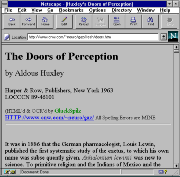
Click the image to read
the full-text.
also worth a look:
www.doorsofperception.com
Aldous Huxley
Promptly projected into a serene world of contemplation, Huxley was disappointed to find that he did not have fabulous hallucinations, but instead the real world became much more real and alive. He finally understood a Zen koan that had previously seemed nonsensical, and delighted in the beauty of commonplace objects.
Fortunately for the reader, Huxley waited until he was sober to set down his ideas, aided by an audio recording of his observations made by a non-participating companion (whose own take on the scene is notably absent). He is reminded of the distinction between the contemplative and active personalities. Is it best to meditate on theology and make the achievement of purity one's primary duty, or should one concentrate more on meeting the needs of the world outside (cf. James 4:17)? Huxley says the drug made him supremely indifferent to worldly cares, but at the same time he was strongly aware of the inadequacy of this perspective. He concludes that an occasional chemically-aided Beatific Vision can help the seeker find the priorities needed for better living. It isn't stated, however, if Huxley became a regular user of mescaline, or if he subscribed to the adage "Once a philosopher, twice a drug fiend."
Link courtesy of David C. Oshel.
| STORY | n/a |
| IDIOM | * * * |
| IDEAS | * * * * |
| COVER | n/a |
From the records of religion and the surviving monuments of poetry and the plastic arts it is very plain that, at most times and in most places, men have attached more importance to the inscape than to objective existents, have felt that what they saw with their eyes shut possessed a spiritually higher significance than what they saw with their eyes open. The reason? Familiarity breeds contempt, and how to survive is a problem ranging in urgency from the chronically tedious to the excruciating. The outer world is what we wake up to every morning of our lives, is the place where, willy-nilly, we must try to make our living. In the inner world there is neither work nor monotony. We visit it only in dreams and musings, and its strangeness is such that we never find the same world on two successive occasions. What wonder, then, if human beings in their search for the divine have generally preferred to look within! Generally, but not always. In their art no less than in their religion, the Taoists and the Zen Buddhists looked beyond visions to the Void, and through the Void at "the ten thousand things" of objective reality. Because of their doctrine of the Word made flesh, Christians should have been able, from the first, to adopt a similar attitude towards the universe around them. But because of the doctrine of the Fall, they found it very hard to do so. As recently as three hundred years ago an expression of thoroughgoing world denial and even world condemnation was both orthodox and comprehensible. "We should feel wonder at nothing at all in Nature except only the Incarnation of Christ." In the seventeenth century, Lallemant's phrase seemed to make sense. Today it has the ring of madness.Send your comments.
